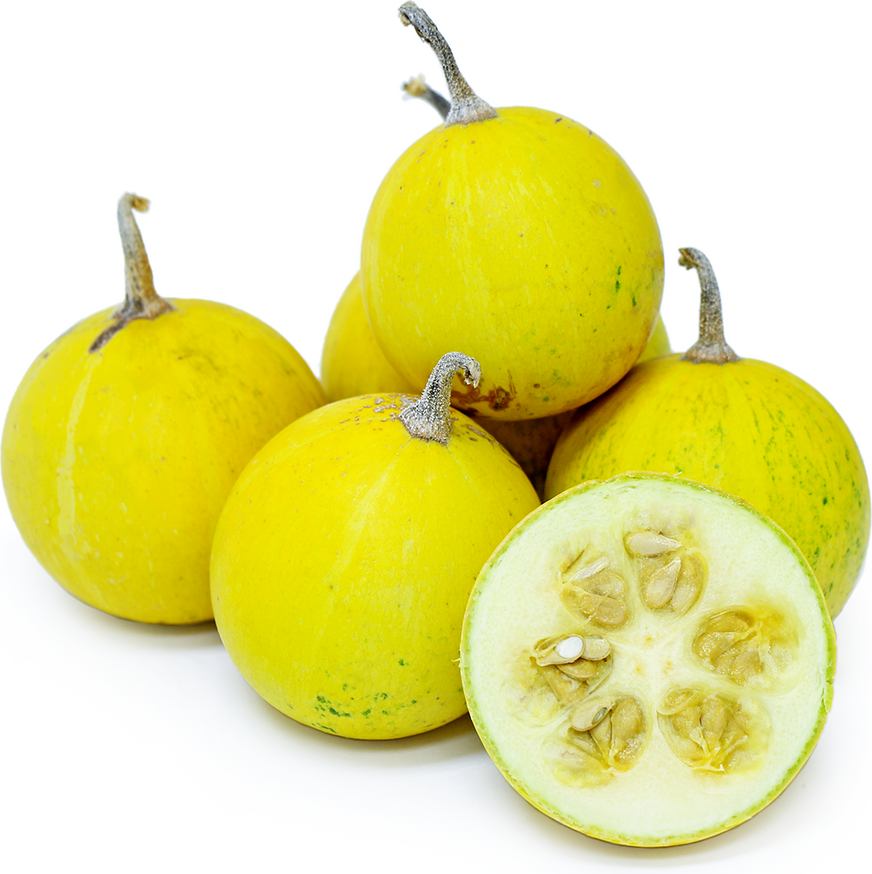


Calabazilla
Estimated Inventory, ea : 0
Description/Taste
Calabazilla is a medium-sized squash, roughly the size of a grapefruit, with a dense weight and spherical shape ranging from 5 to 10 centimeters in diameter. Its outer shell has variegated vertical green and white stripes, reminiscent of a watermelon, and features a thick, bumpy, and sometimes warty rind. As it ripens, the squash's exterior hues fade to a pale canary yellow. Inside, the flesh is dense, firm, and dry with a pale yellow tint. Numerous large, flat seeds are embedded within the flesh, occupying a substantial portion of the internal space. Calabazilla is known for its distinctively bitter, pungent, and musky scent, often giving the impression that it’s overly ripe or beginning to spoil. The flesh can taste exceedingly bitter, primarily due to its high concentration of cucurbitacins, a group of compounds prevalent in the Cucurbitaceae family. The seeds of the Calabazilla lack these bitter compounds and are considered the most edible part of the fruit, often consumed after roasting.
Seasons/Availability
Calabazillas are harvested from late summer to early fall.
Current Facts
Calabazilla, botanically known as Cucurbita foetidissima, is a perennial plant from the Cucurbitaceae family. Often referred to as Buffalo gourd, other common names for Calabazillas are Chilicote, Coyote gourd, Fetid gourd, Fetid Wild pumpkin, Missouri gourd, Prairie gourd, Stinking gourd, Wild gourd, and Wild pumpkin. It’s native to the arid regions of the Southwestern United States and parts of Mexico. Calabazilla contains high levels of cucurbitacin, one of the most bitter compounds found in plants, which serves as a potent natural pesticide and insecticide. This compound is present in all wild gourds and their cultivated relatives, like cucumbers, squash, and melons, albeit in lower concentrations. Due to its extreme bitterness and toxicity, Calabazilla is not typically used for culinary purposes except for roasting its seeds. Despite its toxic nature leading to severe reactions in both livestock and humans if ingested past maturity, it has found applications in traditional medicines as an ingredient in natural soaps, diuretics, and anti-inflammatory remedies, particularly among Native American tribes. Calabazillas are also dried and painted for decorative purposes and are used in Spain as darning balls, a knitting tool for fixing holes in sweaters and socks.
Nutritional Value
When harvested young, Calabazilla is edible and can be enjoyed similarly to squash. It contains nutrients such as vitamin A, vitamin C, and potassium. These nutrients are known for their potential to bolster the immune system, aid in blood pressure regulation, and facilitate wound healing. However, it's important to exercise caution, as mature Calabazilla fruits become inedible due to bitterness. Because of this, the Calabazilla is predominantly consumed for its seeds, which can be roasted and boiled to provide a high source of protein. Oil extracted from Calabazilla seeds is notably rich in linoleic acid, an essential nutrient that maintains healthy skin and plays a significant role in regulating inflammation and immune responses. Calabazilla has been historically valuable to Native Americans for various practical applications. The roots were traditionally used to alleviate chest pain. For treating rheumatism pain, the baked flesh of the gourd was applied to the skin.
Applications
Young Calabazilla gourds are versatile in the kitchen, suitable for raw consumption and cooking, similar to other squashes. However, its use in recipes is less common due to its inedibility when mature. The seeds are more frequently used, offering a warm, nutty flavor that enhances both sweet and savory dishes. They're adaptable to recipes calling for pumpkin seeds, sunflower seeds, or pine nuts. Simple preparation involves sun-drying and roasting with salt, but the seeds can also be ground into flour or boiled into mash. Calabazilla pairs well with ingredients like dried fruits, nuts, herbs, cheeses, grains, and various spices. To keep the gourd fresh, store it in a cool, dry, and ventilated area.
Ethnic/Cultural Info
With a history spanning over nine thousand years, the Cabazilla has been a versatile resource for many different cultures. Native Americans harnessed the saponin glycosides found in Calabazilla fruit to create a sudsy foam, which they used for making soap. This natural property also made the Calabazilla useful as a primitive laundry detergent, helping to clean items like buckskin clothes and blankets. Additionally, dried Calabazilla was often used in crafting drums and rattles for ceremonial purposes. The White Mountain Apache, for instance, incorporated ground Calabazilla leaves for green pigment in their sacred sand paintings.
Geography/History
Calabazilla is indigenous to the United States and Northern Mexico, thriving in warm semiarid and arid conditions, especially where temperatures are high for at least five months annually. This plant demonstrates remarkable resilience and adaptability, making it suitable for challenging environments with limited water and rough terrain. While its resilience has led to an interest in breeding other squash varieties that grow in harsh conditions, Calabazilla remains a wild plant. It’s not commonly cultivated in home gardens or for commercial agriculture and isn’t widely available in markets, mainly limiting Calabazilla’s presence to its natural habitats.




